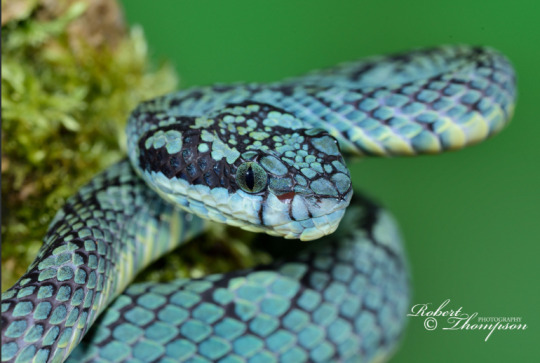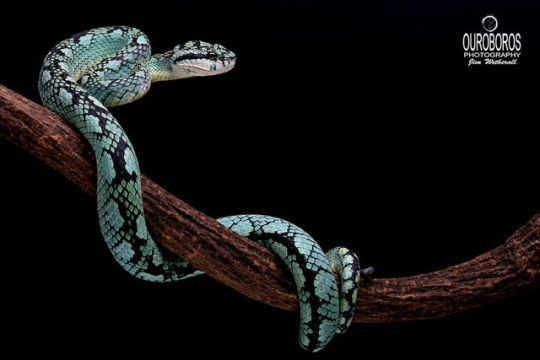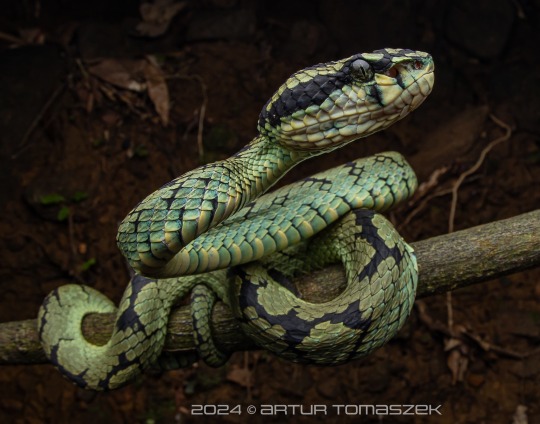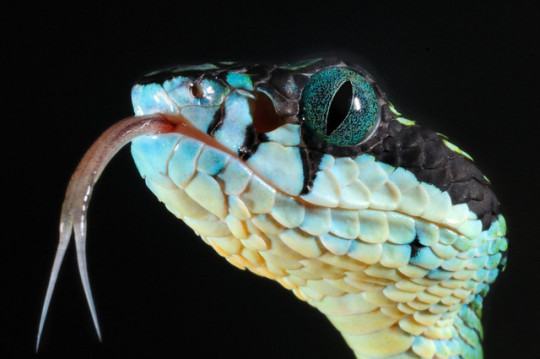#Trigonocephalus
Text
Even as long as the body retained its irritability, a tendency to this habitual movement was evident.
"Journal of Researches into the Natural History and Geology of the Countries Visited During the Voyage of H.M.S. Beagle Round the World, 1832-36" - Charles Darwin
#book quote#the voyage of the beagle#charles darwin#nonfiction#snake#trigonocephalus#cophias#irritability
0 notes
Text

Sri Lankan pit viper (Trimeresurus trigonocephalus)
Photo by Robert Thompson
#sri lanka#ceylon#sri lankan pit viper#pit viper#viper#Trimeresurus trigonocephalus#Trimeresurus#pala polonga#snake#blue#blue snake#colorful snake#reptiles#animals#wildlife#snake portrait#snake photography#nature
34 notes
·
View notes
Text

Sri Lankan Pit Viper (Craspedocephalus trigonocephalus), completely astonished, astounded, and amazed at the stupidest shit he ever heard, family Viperidae, endemic to Sri Lanka
Venomous.
photograph by Liliths Colorful Garden
378 notes
·
View notes
Photo

Trimeresurus trigonocephalus - Sri Lankan green pit viper
132 notes
·
View notes
Photo

Sri Lankan Pit Viper
Trimeresurus trigonocephalus
Source: Here
309 notes
·
View notes
Photo


Island Weirdness #31 -- Tiny Elephants On Parade
Part 2: Flores
Much like Japan, ancient Flores had a succession of dwarf stegodontids -- close relatives of modern elephants that were capable of island-hopping through Indonesia by swimming.
Stegodon sondaari lived on Flores during the Early Pleistocene, about 900,000 years ago, and was the size of a small water buffalo at just 1.2m (3′11″) tall at the shoulder. It was probably descended from the larger Stegodon trigonocephalus, known from Java, and it had proportionally short legs which may have been an adaptation to clambering over rough terrain and steep inclines.
Around 850,000 years ago Stegodon sondaari disappeared from Flores, probably due to a large volcanic eruption, but a new wave of stegodontids quickly recolonized the island. The mid-sized Stegodon florensis probably originated from either Java to the west or Sulawesi to the north, and eventually evolved into a new dwarfed subspecies.
Stegodon florensis insularis wasn’t quite as small as its predecessor, standing around 1.8m tall (5′10″). It probably didn’t shrink quite so much due to the existing presence of various predators on Flores, since it was likely the main prey of large Komodo dragons, it was hunted by Homo floresiensis, and it may also have been occasionally targeted by giant storks.
It seems to have disappeared around the same time as several other unique endemic species, between 50,000 and 20,000 years ago, due to either climate change, another volcanic eruption, or the arrival of modern humans -- or perhaps a combination of all of those factors.

And that’s all for this month... but Island Weirdness will be back later for part 2, with more giants, more dwarfs, and so many elephants.
#island weirdness 2019#paleontology#paleoart#palaeoblr#stegodon#stegodontidae#elephantoidea#elephantiformes#proboscidea#mammal#art#insular dwarfism#flores#indonesia#holocene extinction#island weirdness part 1#tiny elephants on parade
157 notes
·
View notes
Photo

The Sri Lankan Green Pitviper (Trimeresurus trigonocephalus) is a nocturnal and arboreal live bearing snake found across Sri Lanka.
photograph by Dick Bartlett (w/ permission)
37 notes
·
View notes
Link
#gravestone#grave stone#tombstone#Italy#Greece#Italian#Grecian#engraving#antique#illustration#human skull#skull#triangle#alchemy#fire#soul#spirit#dark#morbid#cult#occult#gothic#wicca#pagan#symbolism#death#mortality#memento mori#black and white#B&W
0 notes
Photo

Awesome viper! (Trimeresurus trigonocephalus).
Credit: Lea Pierrefitte
> For more pics, videos & articles visit: herpkeepers.com
#trimeresurus#trimeresurustrigonocephalus#arborealviper#herpkeepers#herp#herps#snake#snakes#viper#viperidae#reptile#reptiles#venomous#venom#hotherps#venomoussnake#venomousreptile#wildlife#wild#exotic#exoticpets#nature#naturelovers#herpetology#biology#creatures#pet#pets#animals
11 notes
·
View notes
Text
Trigonocephalus Nedir?
Trigonocephalus Nedir? | Devamını oku http://bit.ly/2H7h9Xw | #tıp #tıpterimleri #tıpsözlüğü #tıbbiterimler #tıbbisözlük #sözlük
0 notes
Text

Sri Lankan Pit Viper (Craspedocephalus trigonocephalus), family Viperidae, Sri Lanka
Venomous.
Still referred to by some herpetologists as Trimeresurus trigonocephalus.
photograph by Artur Tomaszek (@artur.tomaszek.photo)
#pit viper#viperidae#craspedocephalus#trimeresurus#venomous#snake#reptile#herpetology#animals#nature#asia
247 notes
·
View notes
Photo

(Trimeresurus trigonocephalus) Sri Lankan green pitviper
Mainly hemotoxic. Reported human envenomation symptoms of local pain & swelling generally subside within a few days. Bites & envenomations of plantation workers are relatively common, but only a few human fatalities from bites by this species have been reported.
#Sri Lankan green pitviper#Trimeresurus trigonocephalus#Trimeresurus#snake#nature#earth#reptile#venomous#Viperidae#Crotalinae#animals#viper#pit viper
3K notes
·
View notes
Photo

Sri Lankan Pit Viper
Trimeresurus Trigonocephalus
Source: Here
#snake#snakes#reptile#reptiles#animal#animals#pet#pets#nature#wildlife#cool#interesting#aesthetic#aesthetics#beautiful#pretty#snek#sneks#danger noodle#sri lankan pit viper#pit viper#viper#vipers
1K notes
·
View notes
Text
Trimeresurus trigonocephalus - Beautiful Photography - Fribly
Fribly originally shared:
Trimeresurus trigonocephalus captured by nakkimo
https://plus.google.com/+XMediaStudioValentin/posts/UrvTech6ZXr
0 notes
Text
New Post has been published on https://ngawipost.com/2017/05/463/
NgawiPost.com || Trinil adalah situs paleoantropologi di Indonesia yang sedikit lebih kecil dari situs Sangiran. Tempat ini terletak di Desa Kawu, Kecamatan Kedunggalar, Kabupaten Ngawi, Jawa Timur, kira-kira 13 km sebelum pusat kota Ngawi dari arah kota Solo. Trinil merupakan kawasan di lembah Bengawan Solo yang menjadi hunian kehidupan purba, tepatnya zaman Pleistosen Tengah, sekitar satu juta tahun lalu.
Museum Trinil terletak di dusun Pilang, desa Kawu, Kedunggalar, Ngawi. Secara astronomi terletak pada 7.37444444S, 111.35805556E sekitar 5 kilometer arah utara dari jalan raya Solo-Surabaya. Dari Kota Ngawi, museum ini terletak sekitar 13 kilometer arah barat daya. Untuk menuju museum ini, dari Kota Ngawi wisatawan dapat menggunakan jasa bus umum arah Solo. Wisatawan turun di gapura besar yang menjadi penanda menuju Museum Trinil. Dari gapura tersebut, wisatawan dapat mencarter ojek untuk sampai ke museum dengan menempuh jarak sekitar 5 kilometer.
Pada tahun 1891 Eugène Dubois, yang adalah seorang ahli anatomi menemukan bekas manusia purba pertama di luar Eropa (saat itu) yaitu spesimen manusia Jawa. Pada 1893 Dubois menemukan fosil manusia purba Pithecanthropus erectus serta berbagai fosil hewan dan tumbuhan purba.
Saat ini di Trinil berdiri sebuah museum yang menempati area seluas tiga hektare, dengan koleksi di antaranya fosil tengkorak Pithecantrophus erectus, fosil tulang rahang bawah macan purba (Felis tigris), fosil gading dan gigi geraham atas gajah purba (Stegodon trigonocephalus), dan fosil tanduk banteng purba (Bibos palaeosondaicus). Situs ini dibangun atas prakarsa dari Prof. Teuku Jacob, ahli antropologi ragawi dari Universitas Gadjah Mada.
Disini anda dapat melihat-lihat dan mengamati benda/fosil zaman purba, diantaranya :
Fosil tengkorak manusia purba ( Phitecantropus Erectus Cranium Karang Tengah Ngawi )
Fosil tengkorak manusia purba (Pithecantropus Erectus Cranium Trinil Area)
Fosil tulng rahang bawah macan (Felis Tigris Mandi Bula Trinil Area)
Fosil gigi geraham atas gajah (Stegodon Trigonocephalus Upper Molar Trinil Area),
Fosil tulang paha manusia purba (Phitecantropus Erectus Femur Trinil Area),
Fosil tanduk kerbau (Bubalus Palaeokerabau Horn Trinil Area),
fosil tanduk banteng (Bibos Palaeosondaicus Horn Trinil Area)
Fosil gading gajah purba (Stegodon Trigonocephalus Ivory Trinil Area).
Disamping sebagai tempat rekreasi juga merupakan tempat untuk menambah ilmu pengetahuan, di dalam museum juga terdapat kronologi terbentuknya benua dan lain-lain, kalau anda belum mengunjungi museum Trinil sebaiknya anda mengujunginya apalagi jika anda sedang berada di kawasan Kabupaten Ngawi, disamping Museum Trinil juga masih banyak tempat-tempat rekreasi yang menarik di Kabupaten Ngawi antara Lain, waduk pondok, waduk sangiran, pemandian alam Tawon, air terjun srambang, kebun teh Jamus, Benteng Pendem, dan lain-lainnya.
Diolah dari berbagai sumber
0 notes